Yesterday’s live coverage of the Ukraine conflict can be found here. An archive of our liveblogs can be found here. For an overview and analysis of this developing story see our latest podcast.
Please help The Interpreter to continue providing this valuable information service by making a donation towards our costs.
For links to individual updates click on the timestamps.
For the latest summary of evidence surrounding the shooting down of flight MH17 see our separate article: Evidence Review: Who Shot Down MH17?
In a new human rights report, the United Nations Office of the High Commissioner for Human Rights (OHCHR) has updated its figures for casualties in the war in southeastern Ukraine: 6,417 deaths and 15,962 from mid-April 2014 to May 30, 2015.
Of these, at least 626 are women and girls. The UN cautioned that these were conservative figures and there are likely more.
The report states:
“Serious
human rights abuses, intimidation and harassment of the local
population perpetrated by the armed groups continued to be reported. The
[monitoring mission] received new allegations of killings, torture and
ill-treatment, as well as cases of illegal deprivation of liberty,
forced labour, looting, ransom demands and extortion of money on the
territories controlled by the armed groups.”
High Commission for Human Rights Zeid Ra’ad Al Hussein commented:
“Even with the decrease in hostilities, civilians continue to be killed and wounded. We have documented alarming reports of summary executions by armed groups and are looking into similar allegations against Ukrainian armed forces. We also have horrific accounts of torture and ill-treatment in detention, both by armed groups and Ukrainian law enforcers.”
This is the tenth such report issued by the OHCHR, and like past reports, strives to be “balanced” in equally criticizing both sides of the conflict and demanding justice from Ukrainian authorities for the killings on Maidan Square, overwhelming caused by the OMON riot police directed by deposed former president Viktor Yanukovych, and the deaths after clashes in Odessa in May of last year culminating in the fire at the Trade Unions Building.
Nevertheless, the cumulative information from the reports, such as one issued in July of last year describing 812 kidnappings by the Russian-backed separatists, combine to provide documentation of greater problems on the Russian-backed separatist side and in Russian-occupied Crimea, not recognized as Russian territory by the UN:
Residents of the territories controlled by the armed groups continued to be increasingly isolated from the rest of Ukraine and suffer from a lack of protection in the absence of the rule of law. The situation of the most vulnerable, particularly older people, individuals with disabilities, families with children and people in institutional care, is particularly dire, with many of them having no source of income or being deprived of access to basic social services. The permit system introduced by Ukrainian authorities continues to significantly limit the freedom of movement across the contact line, putting lives at risk. Those seeking to obtain permits can face corrupt practices and long delays.
The report also highlights the lack of justice and accountability for violations that occurred during the Maidan protests more than a year ago, during which at least 117 people died and more than 2,295 were wounded. Similarly, no one has yet been prosecuted in relation to the violence of 2 May 2014 in Odesa.
The situation in the Autonomous Republic of Crimea remains worrying, characterized by human rights violations committed by the de facto authorities applying the laws of the Russian Federation. The report notes that arrests, ill-treatment, torture and intimidation continue to be perpetrated against political opponents, primarily in the Crimean Tatar community, with the knowledge or participation of ‘law enforcement’ or affiliated groups. Legal safeguards for detainees are all but absent. The exercise of the rights to freedom of expression, assembly and religion is mostly limited to groups or individuals loyal to the de facto authorities. Administrative measures, including registration requirements, are used as control mechanisms and tools to prevent the spread of dissenting views.
— Catherine A. Fitzpatrick
A video uploaded to Youtube on May 29 by informator.lg.ua from the channel ATOWaronDonbass shows a group of fighters from the olpolchentsy, the so-called “self-defense” of the self-proclaimed “Donetsk People’s Republic,” but all of them are sending greetings to Novosibirsk, a town in Siberia.
Update: the video is in fact a copy of a video first uploaded April 9.
The first fighter says that he and the men he with whom he is fighting send their greetings to Novosibirsk.
The Russians have unmistakeable non-local Russian accents and send greetings by name to friends and family in Russia.
Some of them are wearing “Novorossiiya” flag patches on their uniforms, yet another indication that while there are claims that “Novorossiya is dead” based on the closure of one Kremlin-paid project involving the unified parliament, Russian-backed fighters continue to kill Ukrainians under the “Novorossiya” banner.
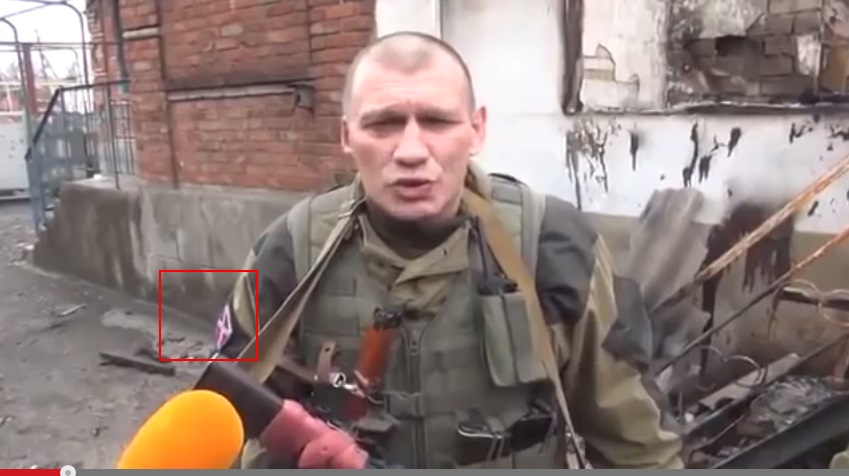
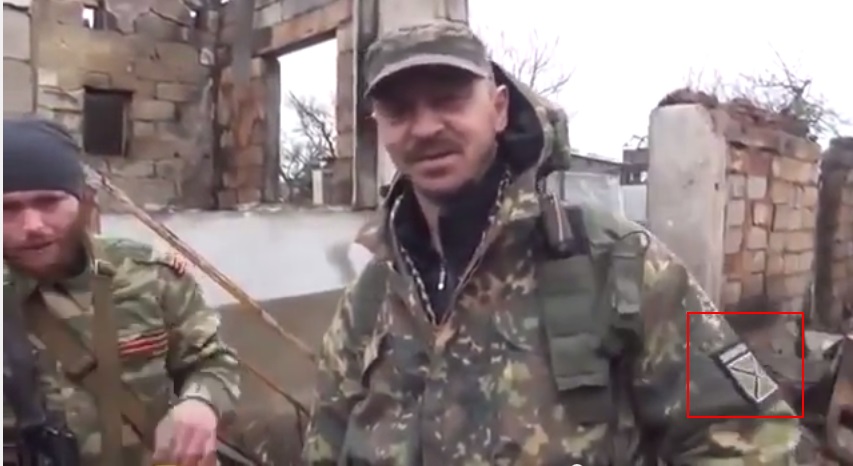
At 0:28, the fighter cries, “Free Motherland! Putin!”
The third man says “Hello, Gorlovka!” with a Donbass Russian accent, and the fourth man says “Hello, Donbass!”
The fifth man says again “Hello, Novosibirsk!” and the last man says “Hello, Rostov!”
Update: Although the metadata for this film showed the date to be May 29, and a reverse image search didn’t find any instances earlier, in fact a reader found the video was uploaded April 9:
Rodina is in fact translated as “Motherland,” not “Fatherland.”
The verified date of April 9 means the men are wearing the Novorossiya patches before the May 19 announcement of the closure of the joint parliament (which was widely mistaken for an end to the “Novorossiya” movement and the aggressive aspirations for more Ukrainian territory.)
Even so, there are other videos showing the continued use of the “Novorossiya” name, emblem and patch on uniforms, such as this one uploaded May 23 by the Fund to Aid Novorossiya (its own name unchanged):
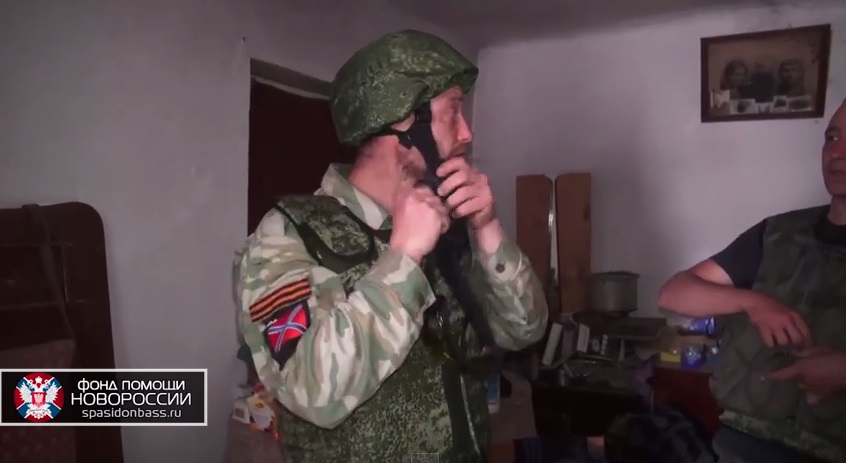
To be sure, in this video made by the “Republican Guard” as some of the DNR fighters are now called, no “Novorossiya” patch is visible.
In this video where some new recruits are being taught how to shoot, they are not shown with “Novorossiya” patches. The shooter cries, “Glory to Russia!” before shooting.
Yet other videos show continued use.
This video, an interview with a separatist fighter whose call-sign is “Pugach” (“Intimidator”), is titled “Liberation of the DNR is the number-one goal,” and he is described as “from the Novorossiya Militia.”
He is wearing only a patch that says “Cyborg-hunter,” referencing the
Ukrainian fighters at the Donetsk Airport, who seemed so invincible
that they were dubbed “Cyborgs.”
Inside the headquarters, there is the DNR flag and the Russian marine infantry flag. The fighter explains the meaning of the different flags, pointing to the Somalia Battalion, headed by the fighter “Givi” (Mikhail Tolstykh), which has the slogan “For Tsar!” and “For Zakharchenko” on it, referencing the call-sign “Tsar” and name of the DNR prime minister Aleksandr Zakharchenko, and the Sparta Battalion, headed by the fighter “Motorola” (Arseny Pavlov). He points to the marine flag as a tsarist-era flag.
Then he says, “This is the flag of Novorossiya,” pointing to the flag used for the Novorossiya movement, which is hanging above them all.
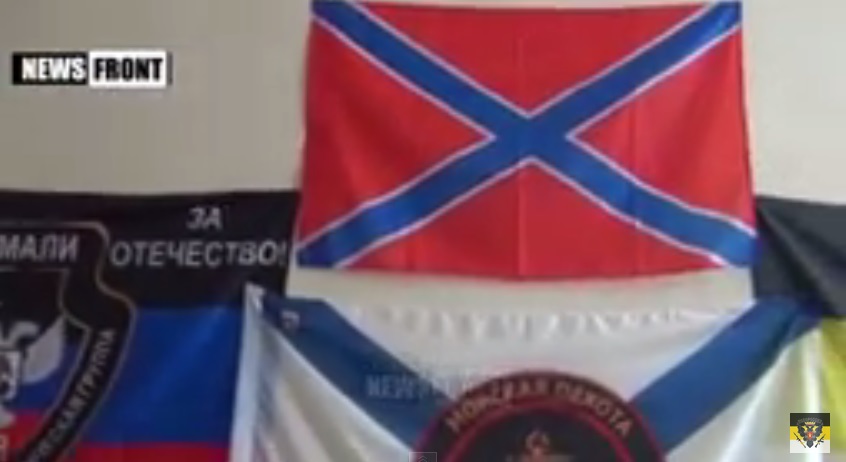
The Novorossiya flag is based on the Russian naval jack and while it looks like the US Confederate flag is not related to it, as it was first used in Imperial Russia from 1696–1917.
This video dated May 26 by the ultrarightist Russian group Sut’ Vremeni (Essence of Time) led by Sergei Kurginyan, was uploaded to their YouTube channel on May 29. It shows a fighter with the Novorossiya patch at 2:25:
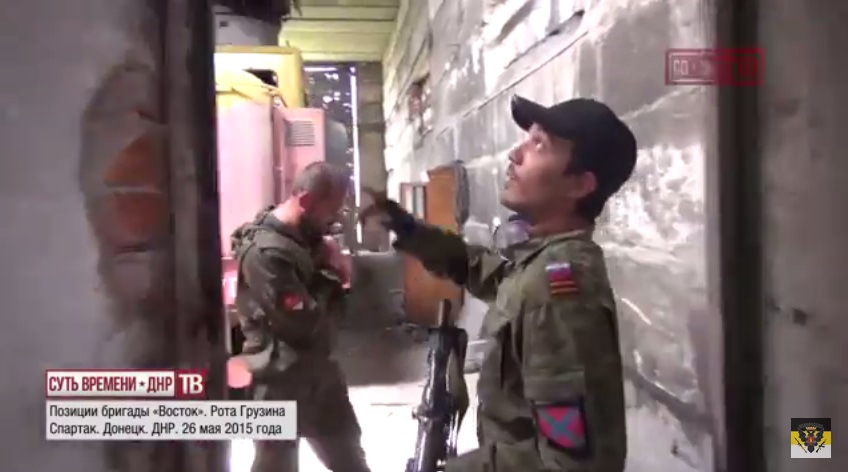
On June 1, a fighter with the call-sign “Vata” (Cotton, the perjorative term Ukrainians use for Russians, referencing workers’ cotton jackets) said in an interview with the YouTube channel News Fron (translation by The Interpreter):
“I’m sick of the outrage. I have been taking part from the very beginning, and since I’ve begun the cause — I have to finish it to the end. I said that if they reaqch Gorlovka, what is to be done? It was scary, and even now it’s still scary sometimes. On July 4, I joined the command of Branka. And soon it will be a year since I’ve been fighting.
There is shelling constantly along the horizon. Such flashes are visible! And they start from 9 in the evening and until morning.”
Novorossiya is capable of reaching even Kiev, but we will show our humaneness and not advance. We will observe the Minsk agreements. They don’t observe them — that’s their right. They say we are terrorists and bandits, then look who is the bandit! If we wanted, we would have long ago been in Kiev.“
On April 22, RT.com editor-in-chief Margarita Simonyan asked Russian Foreign Minister Sergei Lavrov, based on call-in questions from viewers, why Russia did not recognize Novorossiya. He replied that it was a vague term, and it was better to use “LNR” and “DNR” for the self-proclaimed Donetsk and Lugansk People’s Republics,” and that Russia wanted Ukraine “to remain whole” (minus Crimea, of course, which was forcibly annexed by Russia.)
There has been speculation that the Russian leadership may be willing to renounce the larger plans of “Novorossiya,” and a number of commentators have eagerly looked for signs that the “project” of “Novorossiya” is really rolled up, including the pro-Ukrainian Russian site Novy Region, which said in a recent article that Ukraine’s “blockade,” or decision not to allow Russian troops to reach Moldova, is another sign of the “end of Novorossiya.”
The reality is that the Russian-backed fighters keep using the term; they fight with Russian military alongside them and kill Ukrainians under the Novorossiya flag and insignia; and have not shed the aspirations to take even more Ukrainian territory. Even if their leadership makes some tactical move to renounce the hollow “Novorossiya” institutions announced so grandly last year, it is for the sake of the Minsk talks and may not hold.
— Catherine A. Fitzpatrick
“Givi” (Mikhail Tolstykh) aggressively recruiting fighters at the
airport.
Yaroslav Voyansky, whose Russian initials can be seen in the right-hand
corner of the film. But Free Donbas has added the English sub-titles.
The video may have been intended as a propaganda reel in the genre
of previous videos where Givi and other fighters attempt to shame men
leaving on buses with their families to Russia or in other settings,
complaining that they don’t have enough recruits to protect the
self-proclaimed “Donetsk People’s Republic” (DNR).
This particular video backfired, however, as the people talked back.
The video has subtitles that are more or less correct but we have slightly edited the translation:
Woman: If it wasn’t for your weapon, we’d tell you a thing or two.
Givi: What would you tell me?
Woman: If people like you…
Givi: What?
Woman: If people like you would stop defending us, and I don’t understand from what! From whom!
Givi: Alright, let me take you to Kiev if that’s what you want!
Woman: That’s where I’m going!
Givi: Oh, great!
Woman: If you didn’t “protect” us, they wouldn’t have a reason to bomb us!
Givi: Alright, let me take you there!
Givi
calls the men “cowards” for leaving the country for Russia. He demands
to know why they aren’t staying and fighting for the DNR. Givi’s comrade
demands to know why one man he confronts isn’t digging trenches. Givi
cries “He’s a coward.” The man says he has a bad back. A woman says that
another is taking his son to Russia and then returning.
“Are you
asking for help from Russia? Here, Russia has helped you!” he says,
pointing to himself, in an acknowledgement that the “local self defense”
is aided by Russia.
In the comments, some people dispute whether this person is in fact
Givi. But he has an unmistakeable voice and lisp and his face can also
be seen at 0:29.
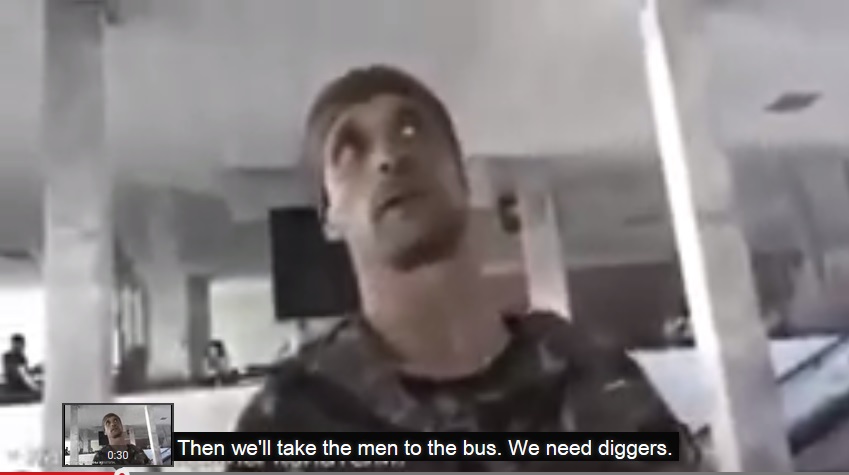
UPDATE: As a number of people have questioned this video, we did some more research.
We found an earlier copy uploaded to The Medvedova YouTube channel on March 9, 2015 but marked as having been made in July 2014, titled “Lugansk. Railroad Station. Summer.” This video is much longer (12:56 minutes) than the video with English subtitles above (3:36 minutes).
The video clearly shows the Lugansk train station signs showing it was not made in Donetsk.
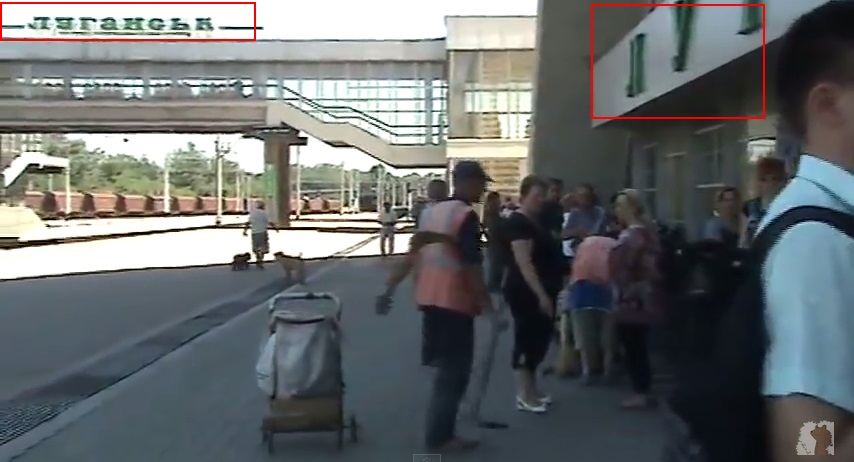
Another video made in 2012 in Lugansk shows the same signs at the train station.
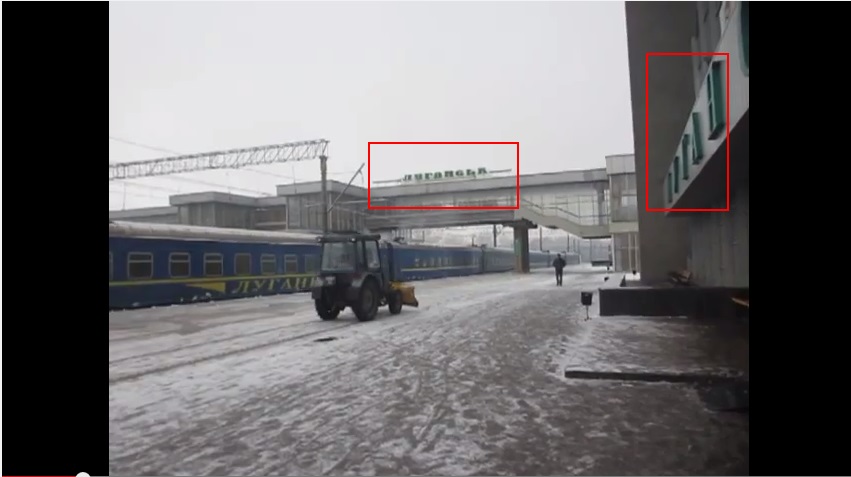
In this longer version of the video, the section with the confrontation with the woman is longer, and she explains that her husband is a citizen of the Russian Federation, that her relative was killed, but that she blames the militants like Givi for causing the Ukrainian Army to have to fire on their city.
This video has more clear scenes with Givi:
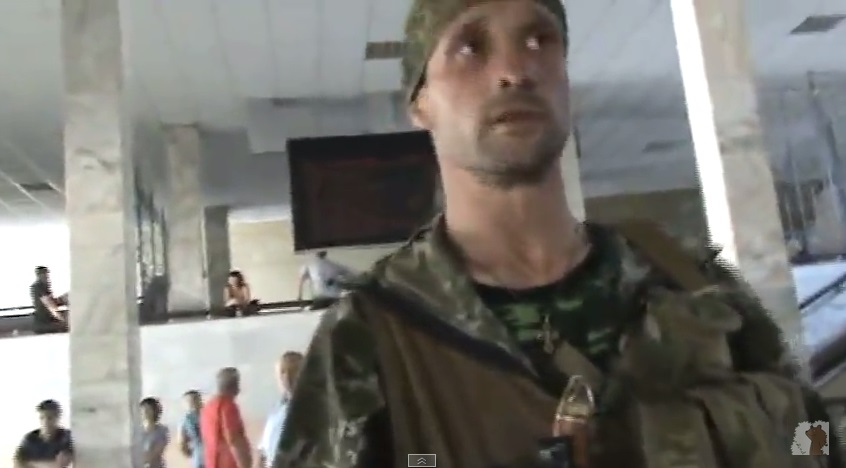
The earliest video we could find of Givi was filmed by Icorpus.ru, the Russian-backed separatists’ propaganda station, dated August 18, 2014.
Russian state TV1 broadcast. It shows that he didn’t have a beard then.
TV1:
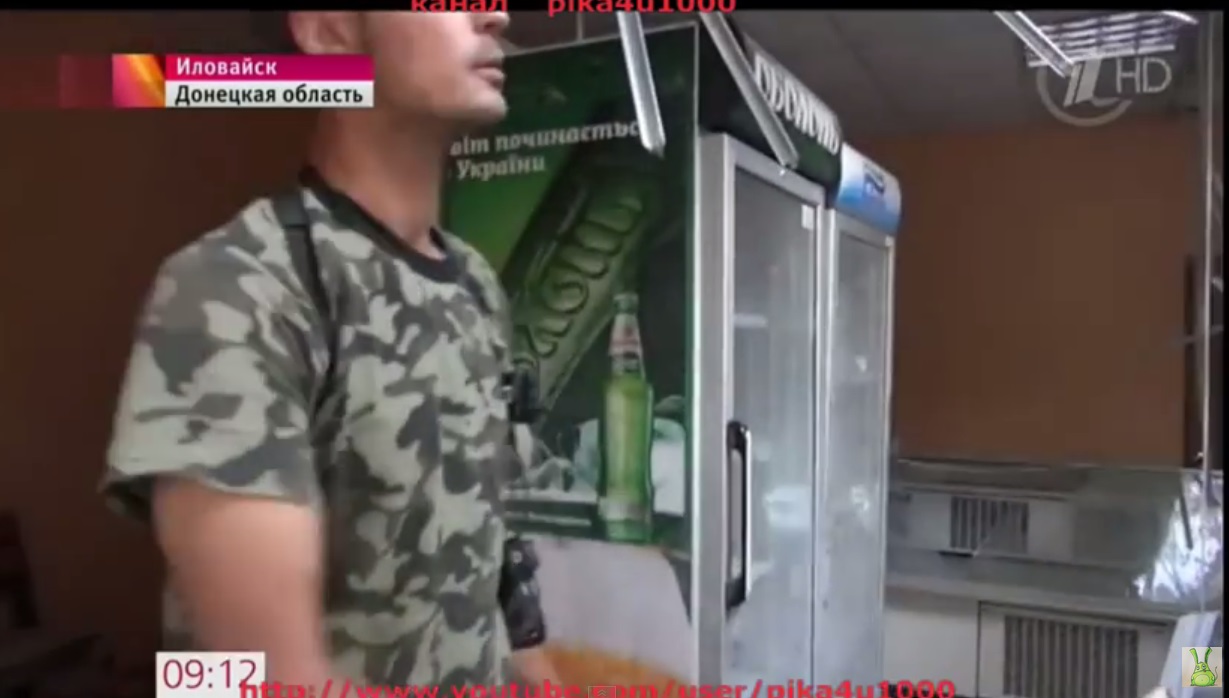
Lugansk train station:
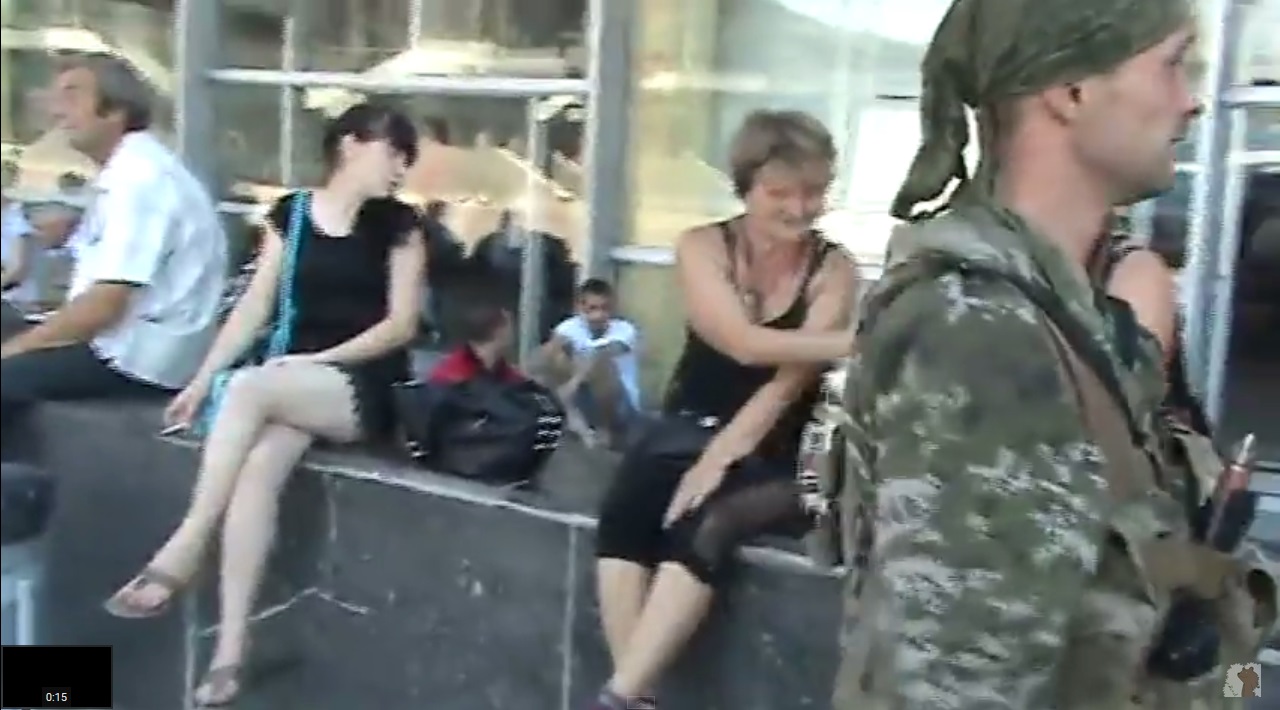
CNN made another
broadcast at that time on September 3, 2014, before Givi was made famous
by Russian TV (around October 2014 when he was at the Donetsk Airport).
In
the CNN video, a fighter is shown talking to Givi who appears to be the
same fighter who was earlier with him at the Lugansk train station.
CNN video:
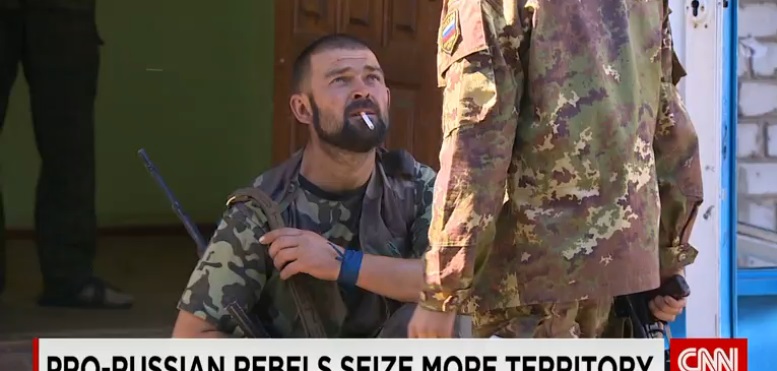
Lugansk train station:
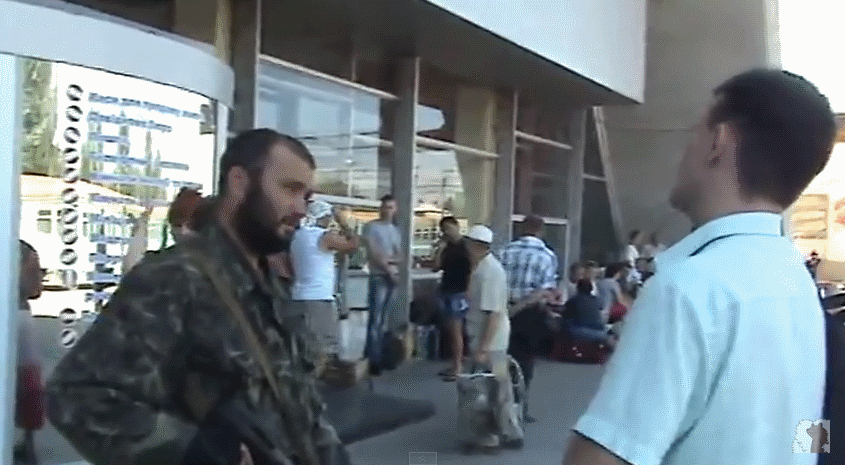
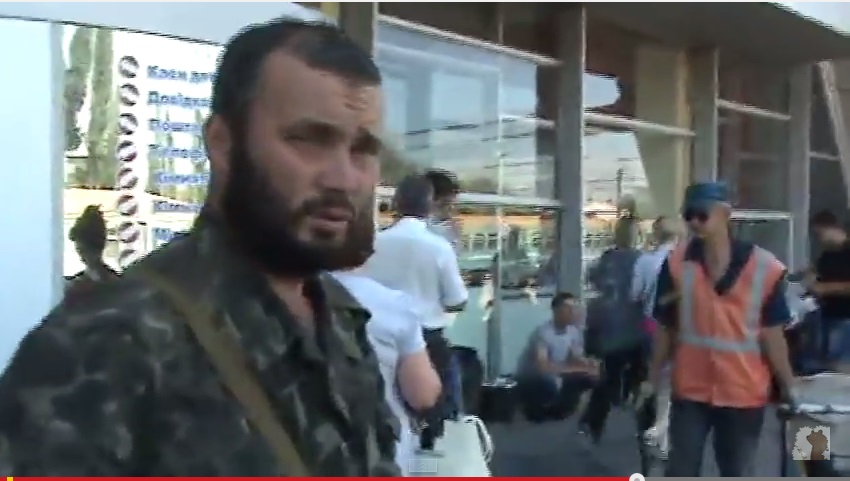
Most of all, the voice sounds alike in all the videos.
— Catherine A. Fitzpatrick
The latest OSCE report, dated last night, May 31, at 19:30 Kiev time, says that there is heavy fighting near Donetsk in particular, which matches other reporting on the conflict:
The SMM continued to observe a significant number of ceasefire violations in and around “Donetsk People’s Republic” (“DPR”)-controlled Donetsk city and Donetsk airport (10km north-west of Donetsk city centre). From observation points in Donetsk city centre and at the city’s central railway station (8km north-west of Donetsk city centre), the SMM heard a total of 253 explosions during the 48-hour period ending at 19:30hrs on 31 May.
The explosions[1] and additional periodic bursts of small arms fire that the SMM heard during the reporting period were consistent with heavy and light weapons fire including tank, artillery, mortar (120mm and 82mm), automatic grenade launcher, and heavy machine gun. The SMM concluded that the explosions and bursts had occurred in or around government-controlled Pisky (7km west of Donetsk) and Opytne (12km north-west of Donetsk), as well as the “DPR”-controlled Donetsk airport (10km north-west of Donetsk), Zhabunky and Spartak (7 and 10km north-north-west of Donetsk).
Both Russia and Ukraine continue to supply different information to the Special Monitoring Mission’s team (SMM) about how many ceasefire violations have occurred and who is responsible for them:
The SMM met with the Ukrainian Armed Forces Major-General, Head of the Ukrainian side to the Joint Centre for Control and Co-ordination (JCCC), and the Russian Federation Armed Forces Colonel-General, Representative of the Armed Forces of the Russian Federation to the JCCC, at the headquarters in Soledar (government-controlled, 77km north-north-east of Donetsk). The incident logs provided to the SMM by each party differed in attribution of responsibility and total numbers, indicating from 76 to 83 ceasefire violations on 30 May and from 56 to 75 ceasefire violations on 31 May.
Whilst in government-controlled Mariupol (103km south of Donetsk), on 29 May, the SMM observed several artillery ‘marking rounds’, detonating in the vicinity of Shyrokyne (10km east of Mariupol) between 21:25 and 21:30hrs. According to the Ukrainian Armed Forces log presented to the SMM at the JCCC, there were four incidents in the vicinity of Shyrokyne on 30 May. The SMM later received communications from the mayor of Shyrokyne and the Representative of the Russian Federation Armed Forces to the JCCC indicating that a civilian had been killed in the village of Shyrokyne on 30 May.
A key focus of fighting continues to be the area north of Lugansk, particularly north and west of the city:
The SMM observed that the overall security situation in Luhansk region remained calm, although on 30 May at 09:52hrs near Lysychansk (government-controlled, 75km north-west of Luhansk) the SMM heard three explosions consistent with outgoing shelling from unknown weapons.
At a “Lugansk People’s Republic” (“LPR”)-controlled location south of the bridge at Stanytsia Luhanska (16km north-west of Luhansk) on 30 May between 09:40 and 11:45hrs, the SMM observed three new artillery strike craters that had not existed at the time of the last SMM patrol at 16:00hrs on 29 May. After an examination, the SMM concluded that the craters were from a powerful low angle strike from a large calibre weapon and that the rounds had clearly come from a northerly direction.
The OSCE continues to monitor holding areas, areas where both the Russian-backed separatists and the Ukrainian military has withdrawn its heavy weaponry in order to comply with the Minsk agreements. There is a trend which has been fairly consistent — heavy equipment is regularly missing from the holding areas, and recently the Russian-backed separatists are often dramatically further out of compliance than the Ukrainian government. This latest report is a clear example of this. First, the single holding area of the Russian-backed fighters that was inspected by the OSCE was missing more equipment than the combined total from eight holding areas of the Ukrainian military. Secondly, all of the equipment in the separatist holding area was missing:
The SMM visited eight Ukrainian Armed Forces heavy weapons holding areas (re-visiting seven, and visiting one for the first time). At three of these sites, the SMM observed that while most previously recorded weapons were in situ and their locations were in compliance with the respective withdrawal lines, some of the heavy weapons previously recorded and accounted for were missing. Not present were six howitzers (152mm 2A65 “Msta-B”), six “Grad” Multiple Rocket Launcher systems (122mm BM-21), and four towed howitzers (152mm 2A36 “Giatzint”). Additionally, the SMM visited one “LPR” heavy weapons holding area and observed the absence of all of the previously recorded military equipment: four tanks (T-64), four armoured combat vehicles (BMP-1s), seven multi-purpose light-armoured vehicle (MTLBs) including four with mounted anti-aircraft “STRELA-10” systems, four multiple rocket launcher systems (BM-2 “GRAD”), four self-propelled howitzers (2SI “Gvozdika” 122mm), four towed howitzers (2A65 “MSTA-B” 152mm), and several support trucks.
The OSCE also looks for heavy equipment moving in the field in areas within the line of demarcation and thus out of compliance with the Minsk agreement. In recent weeks the OSCE has witnessed more separatist armor and heavy weapons out of compliance, though this latest report is the exception to that rule:
Despite claims that the withdrawal of heavy weapons was completed, the SMM’s unmanned aerial vehicle and teams observed a number of stationary or moving tanks (T-64 and T-72) in locations that are non-compliant with the Minsk withdrawal lines, including 21 in government-controlled areas, three in “DPR”-controlled areas, and two in “LPR”-controlled areas.
The OSCE also regularly reports on times when combatants interfere with its mission. Particularly interesting in this report — one of its drones was jammed northeast of Mariupol. It’s not clear where the drone was or over whose territory, but OSCE drones have been jammed multiple times over separatist-controlled territory, including on May 6 and last fall.
On 29 May, at 12:00hrs, an “LPR” member in the “LPR”-controlled village of Pionerske (19km east of Luhansk), aggressively demanded SMM travel authorization papers. The SMM provided relevant documents but the “LPR” member discounted the documents and SMM explanations, and demanded the patrol leave the area immediately ‘without stopping or weapons would be used’.
On 30 May, at 10:00hrs, at an “LPR”-controlled checkpoint near Zhovte (17km north-west of Luhansk), the SMM was denied access to the village of Zhovte, ostensibly due to the threat of mines.
On 31 May, an SMM unmanned aerial vehicle experienced jamming for approximately five minutes along the contact line north-east of Mariupol, entailing a loss of video-feed and ability to monitor.
The full report can be read here.
— James Miller
Ukrainska Pravda reports that Andriy Lysenko, spokesman for the Presidential Administration on the military operation in the south-east, has announced that three Ukrainian soldiers were killed, four wounded and two captured over the last 24 hours.
Earlier today, we reported that Ilya Kiva, deputy head of the Donetsk regional branch of the Interior Ministry, had announced the deaths of two soldiers, and the capture of another during fighting on the outskirts of Marinka.
Lysenko now says that another was captured in this same engagement.
Marinka is a Ukrainian-held suburb on the south-western fringes of separatist-held Donetsk. It has been the scene of increased violence in recent days, marking a shift from the usual concentration of Russian-backed forces’ attacks to the north of the city.
According to the spokesman’s announcement, clashes between Ukrainian forces and diversionary groups of Russian-backed fighters took place near both Slavnoye, south-east of Marinka, and Nikolaevka, north-east of Volnovakha.
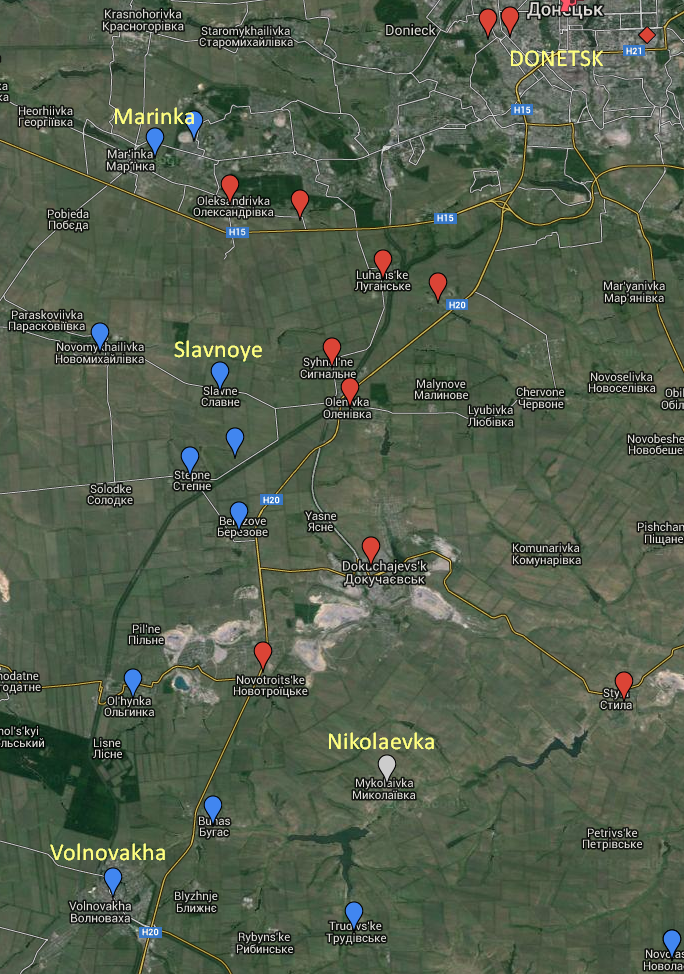
Lysenko said that efforts are under way to establish the captured soldiers’ location and obtain their release.
— Pierre Vaux
RFE/RL has an article and video today assessing a new set of trenches which have been built in Kharkiv. While the Ukrainian government has been busy preparing for the potential of a full-scale Russian invasion by building defenses across much of the country, many are skeptical as to whether the preparations would survive an actual Russian attack:
Regional Governor Ihor Raynin told RFE/RL of state-of-the-art fortifications being built here to guard against an invasion from Russia, 30 kilometers up the road, and in the south to ward off any advance by Moscow-backed separatists from the Donetsk and Luhansk provinces.
But Oleksandr Zalyvan, a military adviser who once served with NATO peacekeeping forces in Bosnia, is not impressed. He would never agree to be deployed in the trenches, he says — Russian tanks would destroy them and everyone nearby in an hour.
“It’s public relations,” Zalyvan says.
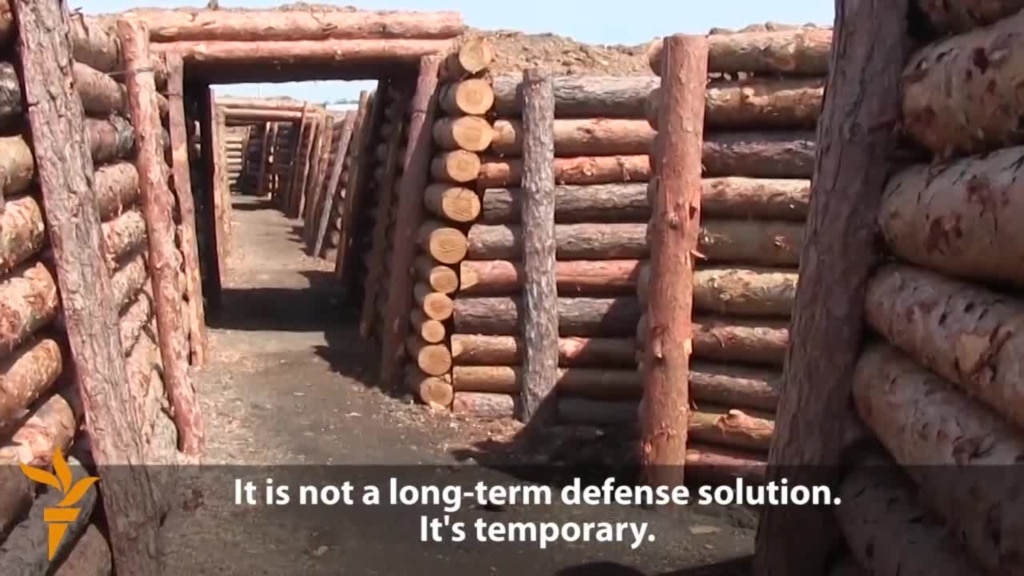
Symbols of Ukraine's Strength Hide Tensions in Kharkiv
KHARKIV, Ukraine — Beside an overpass eight kilometers from the center of Kharkiv lies a newly dug network of trenches lined with bark so fresh the sap still oozes out.
UNIAN reports, citing the press office of the governor of the Lugansk region, Hennadiy Moskal, that a 14-year-old boy and his father were killed by grenade booby trap in Ukrainian-held Stanitsa Luganskaya yesterday morning.
A 55-year-old man with two sons, all being residents of the village of Nyzhnia Vilkhova in Ukrainian-controlled territory of Stanychno-Luhansk district, were moving towards a railway bridge on a bank of the River Siversky Donets, and walked straight into a booby trap with a hidden hand-grenade.
The father and his 14-year-old son died in the blast; the other son (his age is being verified) remained alive and reported about the grenade explosion to the police.
Investigators are now working on the site, the press service said.
— Pierre Vaux
Ukrainian government sources claim that Russian-backed forces attacked two civilian crossing points on the front line last night.
The press office of the governor of the Lugansk region, Hennadiy Moskal, claimed today that, between 18:00 and 21:00 last night, Russian-backed forces fired on a military checkpoint at the only crossing point in the region, in the village of Rodina, north of Pervomaysk.
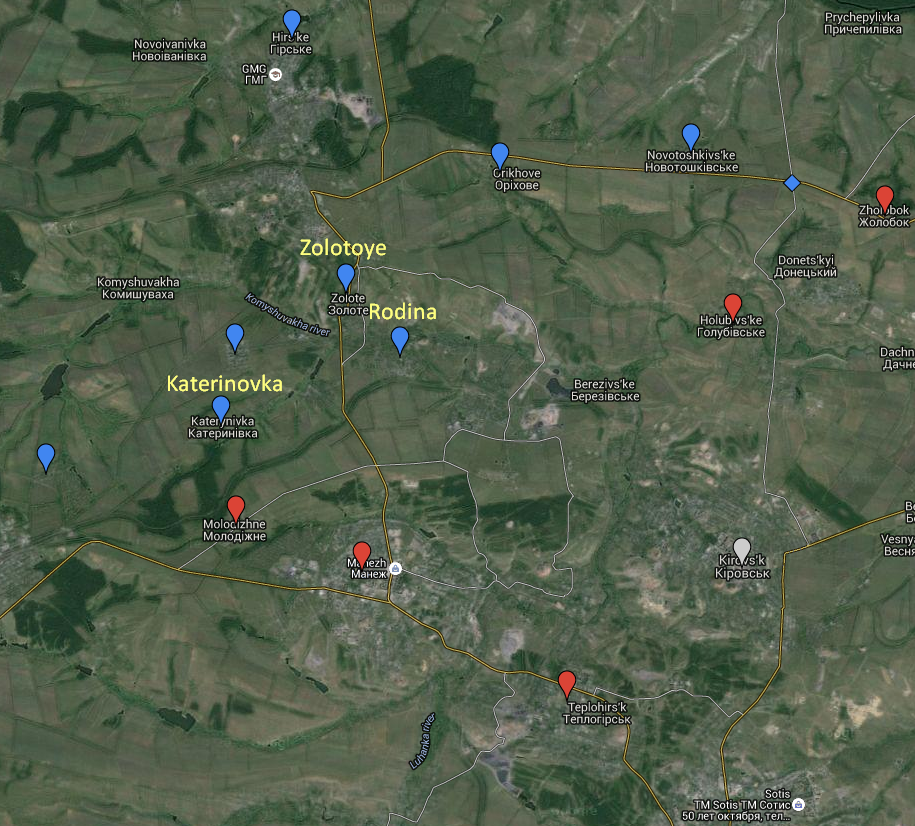
Amongst the weapons used by Russian-backed fighters in their attack was the powerful WW2-era Simonov PTRS-41 anti-tank rifle.
Moskal’s office report no military or civilian casualties.
The Ukrainian military’s ATO Press Centre reports that Russian-backed fighters shelled the crossing point at Zaytsevo, north of Gorlovka, with tanks and artillery.
The press centre claims that a large number of civilians were gathered at this checkpoint.
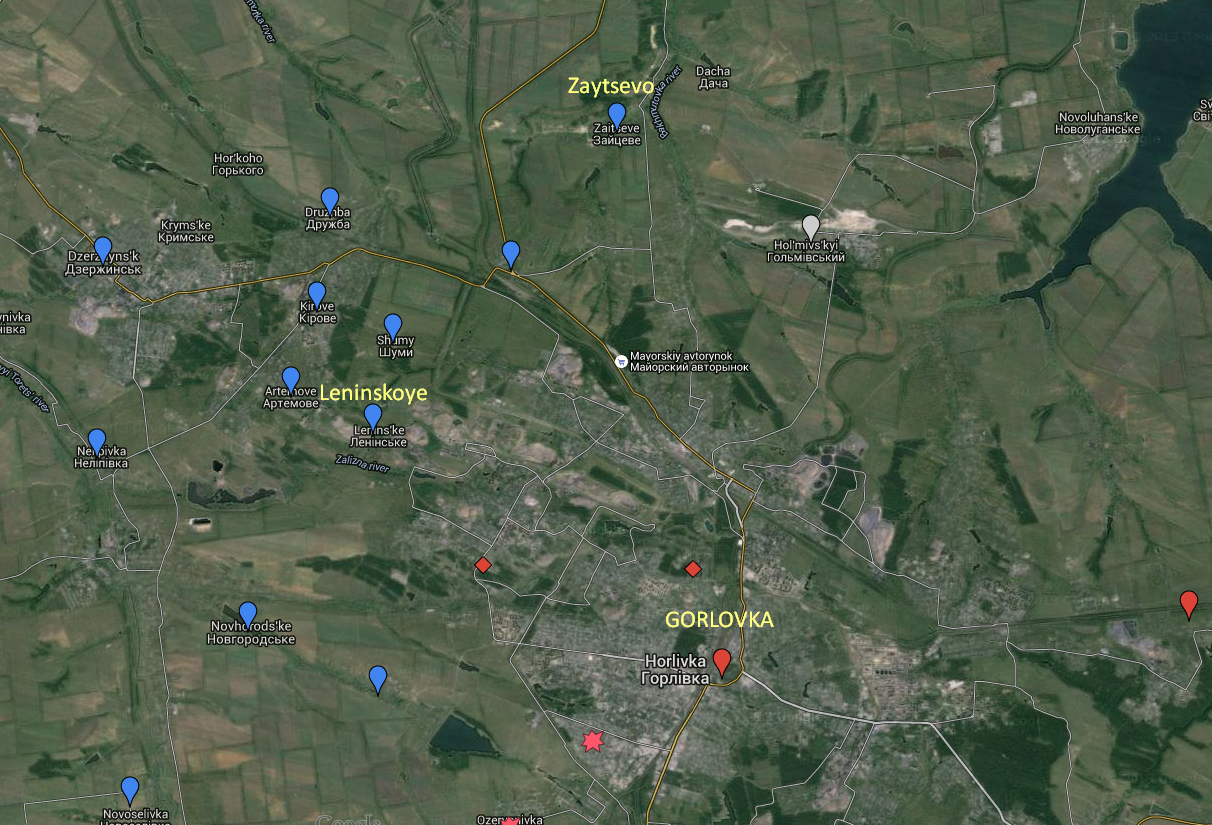
Leninskoye, around 10 kilometres south-west of Zaytsevo, was reportedly attacked with mortars and heavy machine guns.
Both reports also describe attacks on other Ukrainian positions across the front line last night.
According to the ATO Press Centre, Russian-backed forces shelled Peski, Starognatovka and the Butovka mine, all north of Donetsk, with heavy-calibre mortars between 18:00 and midnight.
Krasny Pakhar, a Ukrainian-held village, north-east of Svetlodarsk, was shelled for about an hour by a tank.
In the Mariupol area, Ukrainian positions in Shirokino were attacked with mortars, grenade launchers, artillery and small arms.
Meanwhile Moskal’s office reported that Russian- backed fighters had fired on Schastye with automatic grenade launchers and small arms from separatist-held Vesyolaya Gora.
The attacks continued into the morning in the Lugansk region.
According to their report, Ukrainian positions in Katerinovka, around 5 kilometres west of Rodina, were attacked at 1:06 am.
At 5:50 a Ukrainian checkpoint on the outskirts of Zolotoye was fired on with mortars and small arms.
— Pierre Vaux
Novosti Donbassa reports that Ilya Kiva, deputy head of the Donetsk regional branch of the Interior Ministry, has told Channel 24 that two Ukrainian soldiers have been killed and one wounded in a battle outside Marinka, a suburb west of Donetsk.
According to Kiva, a group of around 10-15 Russian-backed fighters approached Marinka between two checkpoints. During the fighting the attackers managed to capture a Ukrainian soldier.
Novosti Donbassa reports that intense fighting took place practically throughout yesterday on the outskirts of Marinka. According to the report, all attacks were repelled by Ukrainian forces.
— Pierre Vaux